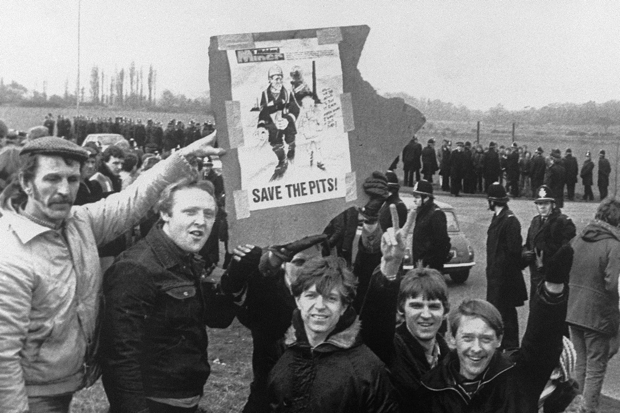‘Did you find it a good read?’ asked Harrriett Gilbert.
An incredibly long drawn-out sigh from Mr Paxman.
‘I think it’s really unsatisfactory,’ he at last replied.
‘But Jeremy,’ retorted Professor Beard, ‘I don’t think you’ve read it carefully enough.’
The eminent classicist from Cambridge is not afraid of conflict. She must eat her students for breakfast, loving an argument, which she of course will always win. Mary Beard didn’t just disagree with Paxman but insisted that her way of seeing, her interpretation, was the right one.
She and Paxman were Gilbert’s guests on the first of a new series of A Good Read (Radio 4), in which the guests are expected to choose their favourite book and to persuade us to read it too. On Tuesday they were talking about Beard’s choice, The Return of Martin Guerre, by the historian Natalie Zemon Davis, a medieval mystery about mistaken identity based on a true story (also made into a film). Paxman was not impressed by the academic dryness of the writing and the footnotes. ‘I thought this programme was called A Good Read,’ he insisted. Undaunted, Beard told him sternly, ‘Reading’s about what happens in your head after the words on the page, Jeremy.’
The programme has never been so entertaining, or so revealing about the character of the guests — Beard’s self-righteousness seeping through the airwaves as she rose to the bait dangled by Paxman. His book choice (Ben Fountain’s Billy Lynn’s Long Halftime Walk) was in turn deemed by Beard to be overwritten, laddish and not subtle enough. Both were so competitive, trading quotes to prove their point. But it was hard to decide who had won what had become a battle of the bookworms. Beard scored in probably being right about the literary value of the books under discussion; Paxman, though, came across as more passionate about reading itself, that particular pleasure of getting lost in a book, of succumbing to narrative.
Over on Radio 3 I was intrigued by this week’s experimental documentary Between the Ears, which took us to the beach at Dungeness in the company of the Mercury Prize-nominated and newly elected Next Generation poet Kate Tempest. More than a Desert on Saturday night (produced by Peter Meanwell) was described as ‘a radio poem’ set on the Kent beach once inhabited by the artist, filmmaker and gardener Derek Jarman.
Tempest’s rapping poems, inspired by hours spent wandering that bleak shoreline, were interwoven with Jarman’s diary notes and the thoughts of long-time residents of this desolate corner of England. ‘It feels like the world is behind us,’ she said, crunching across the shingle, and conjuring up images of an empty landscape, bleached of colour, swept clean by the wind and echoing to the sound of waves beating on pebbles.
Tempest’s style of delivery, declaiming above the wind, was straight out of Lear (she was born Kate Calvert but as a performer changed her surname in homage to Shakespeare). ‘When the wind dies down it’s so quiet you can hear things being heard,’ she told us. Later, watching the unceasing work of the waves persuades her that ‘Time is nothing’. But after about ten minutes I switched off in my head, retreating from her voice. It was too strident, too monotone and I wanted a change of pace. I also missed a sense of something being unfolded, of being told for the first time.
This became even more obvious after listening to Cathy FitzGerald’s latest documentary for Radio 4, How to Dig a Grave (Wednesday). FitzGerald has a soft, lilting voice, perfectly paced and modulated to make an impact on the mind. And what she said was so pertinent, going right to the heart of what matters. She wonders why we now regard gravediggers so warily, not wanting to know them, worried about that stuff under their fingernails, what might it be? Once upon a time, she reminded us, we ourselves would have washed the bodies of our loved ones and lifted the soil to dig their graves, making ‘a safe, dark home for their bones’. Now we cremate, or leave it to someone else to dig the grave and cover it up after the interment. ‘The gravedigger understands things the rest of us forgot a long time ago,’ says FitzGerald. ‘Things, now I’m in the middle of my life, it might be helpful to know.’
She talked to Stevie who’s been digging graves (or rather lairs) in Kilmarnock, south-west of Glasgow, for 25 years. He tells her about the crows that are always hovering around cemeteries, picking out the flowers from the vases as they hunt for snails or slugs. The crows sit on either side of the entrance to the graveyard, a couple of them, waiting for you, counting off your days. Fitz-Gerald offers to help with digging. At the bottom of the narrow six-foot hole, she realises, ‘There are few things more inescapably real than an empty grave, with its damp air and odour of the subterranean.’






Comments